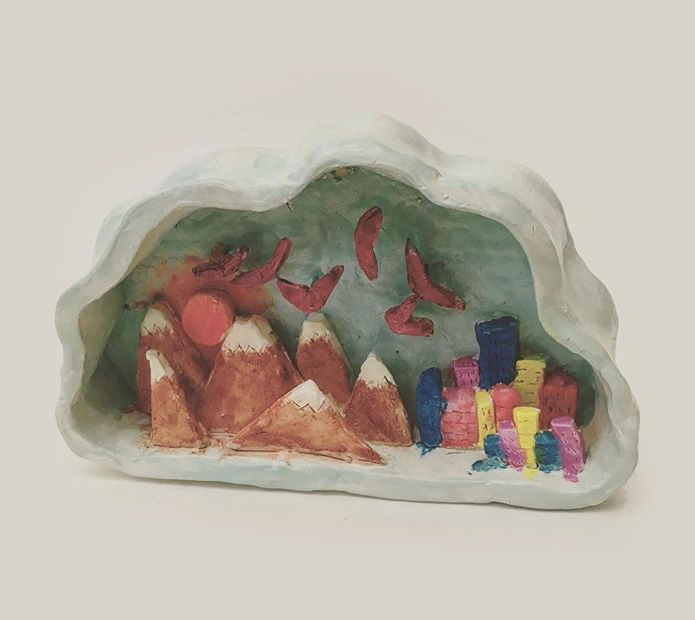Amy Lou Abernathy sent this to me. ‘Helena was assigned to write an essay on “something you thought would be really difficult.” She wrote about the continuous line drawing she’s working on right now at your studio. Thought you might be interested in reading it:’
Well, I was. It is a wonderful insight into a student’s world:

LEGATO
by Helena Abernathy
Sharpie and Watercolor.
‘It hangs above a window. Halfway painted with layered shades, tones, tints, and colors, depicting cakes, goblets, plates and doors, it reflects a still life. Lemon-greens, aquamarines, orange-reds and red-oranges, it’s a rainbow of my creation. I never thought I would be able to draw this picture. I never even wanted to start, it sounded so difficult. The part I though would be hardest of all was the simplest. The whole picture needed to be constructed out of one line.
I had to create this artwork because I am taking an art class. I want to get into Arts Magnet, and the connection between the two is fairly self-explanatory. I thought this technique of one-line contour drawing would be hard. A contour drawing, or continuous line drawing, is a piece of artwork where the artist uses only one line to create a picture. In this technique, you must trace back over outlines you’ve already made to reach other areas and shapes. Since I have trouble with simply sketching still-lifes, I couldn’t imagine trying to make one with a single, continuous line. When I was to begin, I set up a ‘drawing horse’, a special clipboard-supporting bench that an artist straddles in order to sketch an object correctly. I clamped a large sheet of paper onto a huge clipboard and got to work. I started my line in the bottom right corner. The table with the still life was draped in fabric, so I began my piece by outlining the cloth. When I first started, it was very difficult. I continued to draw folds in the fabric too early or too late, and made my lines too long or too short, but as time went on, I started to get the hang of it. The picture started to flow out as easily as the ink from the tip of the pen. When I finished drawing the whole still-life on the table, I was surprised and a little worried because the picture only took up half the room on the paper. I was at a loss of what to do, until I realized that the picture didn’t have to end where the still life did. Behind it were tables, rolls of paper, the entrance to the building, the exit sign above it, lights hanging from the ceiling, pieces of art that other children had done, and strange objects set up in other still-lifes around the room. So I decided to draw everything I could see, to put it all on the paper. And, when I was completely done, I put down the fine-tipped Sharpie I was holding, looked at my work, and felt proud.
Even though I thought that the continuous line drawing would be the most difficult piece of art I had ever made, I tried it, and I’m really glad I did. I learned that I enjoy this style of drawing, and that proportion, the aspect I find the hardest in all still-lifes, is much easier in a contour drawing. I think that this is the best piece of art I’ve ever made. When I look at it, and when I think about making it, it seems to flow from one object to another, one line linking everything together. That suggested the perfect name for it: Legato, a Latin musical term that means smooth and connected. Now I think that contour drawings may not be so difficult after all.’
Helena Abernathy, Age 13

